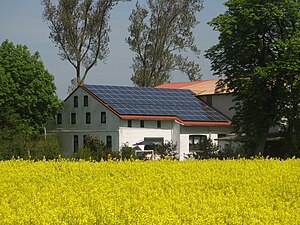 Image via Wikipediaby Garry Baverstock
Image via Wikipediaby Garry BaverstockGreen building design will become a much sought-after specialty as the Western world is forced to address the affordability of its housing for the average home owner. As we concentrate on the rates of consumption and the sizes of our homes to address some of the many problems of climate change, we expect to find solutions that can both meet our expectations while reducing our impact on the environment.
Trend To Larger Homes
When countries experience financial booms, home sizes typically grow larger, demanding more and more energy to support the lifestyle. Thanks to the mineral resources boom, there has been a noticeable trend to larger size homes in Australia, which has been coupled with a trend to smaller sized families living in those homes.
We are developing patterns of living that are increasingly unaffordable and definitely unsustainable. In a paper entitled 'Affordability through Modesty' Dr. Linley Lutton clearly shows we are heading the wrong way. He looks at how we may start to undo the damage of wasteful patterns of development and increase density while making homes more affordable. The use of low energy or green building designs are a step forward in making homes future-proofed against the climate change problem.
Pressure For Continual Growth
One hot political issue worldwide is population growth.The fact that modern economies are based largely in continual population growth to maintain their economic growth is a major problem in itself. Given the destruction of natural habitats and depletion of the earth's resources, if one looks at it logically, it is a self-defeating strategy.
It stands to reason that this approach will come to an end. Are we going to wait until we have destroyed the natural world beyond repair and thus create mass extinctions of human populations? Or are we going to look ahead and take intelligent steps to make this a truly sustainable world for life on earth by striking the right balance?
Dr. Lutton has shown in addressing climate change, what many specialists in the solar energy industry have known for a long time. Our large building companies have been simply responding to the increasing expectations of the populace and putting pressure on government planning agencies to allow them to do so. In the end nobody wins.
The Meaning Of Sustainability
In 1987 the World Commission on Environment and Development, a U.N. body entrusted to report the environment and the impact of buildings on the environment, first termed the concept of true 'sustainability'. Although at that time the term 'sustainability' included 'ecological' and 'ecologically sustainable development', the accepted meaning of 'sustainability' has since been corrupted and watered-down.
In his talk 'Project Homes Big House-Small House', Dr. Lutton describes the issues in explicit terms and offers solutions as an urban designer and planner. His presentation looks at successful models of the past and how we have destroyed the whole notion of public interest through unbridled consumption.
Green Building Design Is More Than Solar Panels
If we are to have any chance of addressing climate change we must realize that it is not sufficient to place a number of solar panels on the roof or hook up to a nuclear reactor. True green building design goes much further than this. Over 50% of greenhouse gases in the modern economies are produced from our built environments and its associated infrastructure. We simply will not solve the potential catastrophic future resulting from climate change if we do to change our building culture. Over half of the built environment comprises housing and therefore, the way we live, the patterns of our housing development and our rates of consumption, will determine greatly our future existence on this planet.
We need to change the way our society thinks in relation to our housing.
As we adapt our built environment to live more economically, with less consumption of materials, we need to integrate green building design principles and utilize solar and low energy technologies to complete the picture.
In so doing we should, over time, reduce our dependence on carbon-polluting energy sources by over 50%. Reducing the peak load demand will enable a more economically viable transition to new clean energy sources.
About Garry Baverstock
Garry Baverstock, A.M. Leading Australian architect in passive solar design, challenges government to take the initiative in the matter of climate change.
Need low energy building design expertise? Find a detailed green building design data manual here: Green Building Design Guide Solar and Renewable Energy information is our passion: solar-e.com
Article Source: http://EzineArticles.com/?expert=Garry_Baverstock
Article Source: http://EzineArticles.com/6278712

No comments:
Post a Comment